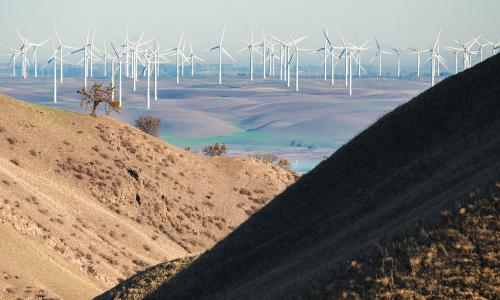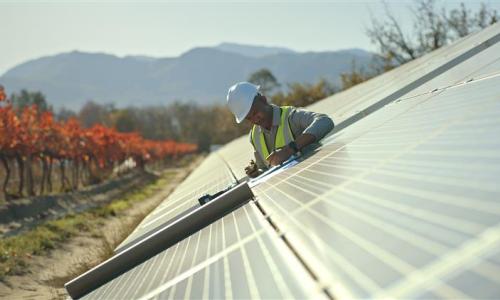Gas-fired power plants are the largest source of carbon emissions in the US electricity sector and a major source of pollution. By investing in renewable energy, we can directly ramp down gas—and decrease its climate, health, and environmental harms.
Unfortunately, the fossil fuel industry and its allies are increasingly proposing gas-oriented solutions for addressing gas plant carbon pollution. These include hydrogen cofiring, carbon capture and storage, and biomethane. Because these approaches are all based on the full, ongoing use of gas plants, they fail to address many of these plants’ ongoing and unjust harms.
In this analysis, we took a fuller look at the climate implications of the industry’s proposed approaches. We found that heat-trapping emissions potentially arising from other steps in the process could undermine their overall reductions.
Our issue brief and customizable tool, available below, are intended to support decisionmakers, advocates, and the public in considering the full picture—of both carbon and non-carbon impacts—as they evaluate proposals for reducing gas plant pollution in their own communities.
Beyond the Smokestack
This is an online version of the report. The full issue brief can be downloaded here.
Gas-fired power plants are the largest source of electricity in the United States, supplying more than 40 percent of US electricity in 2023 (EIA 2024e). They are now also the largest source of carbon dioxide (CO2) pollution from the US power sector, which is itself the secondlargest source of US CO2 emissions economy-wide (EIA 2024c; EPA 2024c). Every path to addressing our nation’s climate commitments and public health priorities calls for a cleanedup power sector—and that makes reducing CO2 and other harmful emissions from gas plants an urgent priority.
CO2 emissions from smokestacks are just one way that gas plants exacerbate climate change. Relying on gas at a plant also results in methane pollution from gas extraction and transport. Methane, the primary component of gas, is more potent than CO2 from a climate perspective, trapping 28 times as much heat over a 100-year time frame (EIA 2024b; Smith et al. 2021). As a result, upstream methane leakage can substantially increase a plant’s overall climate impact.
Furthermore, gas plants cause harm to people and communities beyond the plant-level and upstream climate impacts. A key non-carbon pollutant of concern from gas plants is nitrogen oxides (NOx), which cause and exacerbate respiratory diseases, especially asthma (EPA 2024a). Additional health-harming emissions include hazardous air pollutants, sulfur oxides (SOx), and particulate matter (UCS 2023). These harms are inequitably borne; while people of color and people with low incomes constitute 40 percent and 30 percent of the US population, respectively, they make up 54 percent and 34 percent of people living within three miles of a gas plant (Yang 2024; EPA 2023). But even before the point of gas combustion, its extraction, processing, and transport pollute air and water. Air pollution from gas and oil production caused an estimated $77 billion in total health impacts in a single year, chiefly from NOx, ozone, and particulate matter (Buonocore et al. 2023).
So how do we tackle gas plant pollution?
Using renewable energy sources to produce electricity, aided by energy storage, can directly reduce our use of gas power plants, thereby avoiding the range of harms at the plant and beyond associated with that gas plant use. Solar and wind facilities generate electricity with no CO2 emissions, do not contribute to methane emissions, and have life cycle carbon, air, and water impacts that are a small fraction of those from gas plants (see, e.g., NREL 2021; Millstein, O’Shaughnessy, and Wiser 2024; Meldrum et al. 2013).
Because increasing renewables usage can directly reduce gas usage, however, the fossil fuel industry and vested utilities have started proposing ways to incrementally cut gas plant carbon emissions that still enable the full, ongoing use of these facilities. These approaches include partially or wholly fueling the plants with hydrogen or biomethane (methane sourced from organic matter) or capturing some of the CO2 produced when gas is burned and storing it in geologic formations.
Considering these approaches more fully, however, makes clear that they fail to measure up to what can be achieved by renewables when it comes to overall reductions in climate emissions, public health impacts, and costs—sometimes by a little, but often by a lot. Moreover, these approaches perpetuate ongoing gas plant problems and inequities, and introduce new ones
This issue brief examines a fuller range of climate and health implications of incorporating hydrogen cofiring, carbon capture and storage (CCS), or biomethane use in gas plants, stepping through what each approach might mean in terms of
- plant CO2 emissions
- broader emissions of CO2 and other heat-trapping gases from using the given fuel or technology, and
- non-climate consequences to people and the environment, including of other pollution, costs, and water and land use.
This brief includes results from a new, publicly available analytic tool developed by the Union of Concerned Scientists (UCS 2024), using an illustrative example of targeting power plant CO2 reductions of 90 percent via each approach to demonstrate how focusing on a narrow, combustion-only target can fail to capture the full emissions impact of each approach. The document also explores the implications of using renewable energy instead to drive down the use of gas.
To deliver the best outcomes for people and planet, decisionmaking around proposals to cut a gas plant’s carbon pollution must look beyond the smokestack to the full suite of climate impacts and the comprehensive array of broader impacts to the public. Transparent evaluations of these impacts are critical for enabling informed community and decisionmaker engagement and securing the best outcomes.
When we consider the options and do the math, the answer is unequivocally clear: the best way to reduce gas plant carbon emissions—and gas plants’ associated harms—is to use gas plants less by using renewables more.
Downloads
Citation
Rogers, John, Maria Chavez and Julie McNamara. 2024. Beyond the Smokestack. Cambridge, MA: Union of Concerned Scientists. https://doi.org/10.47923/2024.15637




